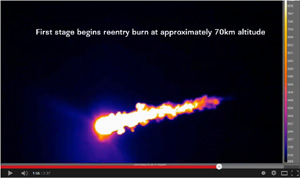 By studying the thermal imaging data, recently catpured by NASA, from a SpaceX Falcon 9 rocket during its descent phase of flight, the nation’s space agency hopes to gain some engineering insight for the development of future missions which will land on the surface of Mars.
By studying the thermal imaging data, recently catpured by NASA, from a SpaceX Falcon 9 rocket during its descent phase of flight, the nation’s space agency hopes to gain some engineering insight for the development of future missions which will land on the surface of Mars.
The images, and video seen below, were taken during a September 2014 launch of the Falcon 9 Rocket from Cape Canaveral Air Force Station in Florida. To record the data, NASA equipped two WB-57 twin jet engine high-altitude research aircraft from the U. S. Navy with advanced instrumentation.
Equipped with a long-range infrared optical system and a unique full-motion video camera system gimbal-mounted on the nose, the aircraft collected full-color high definition and infrared video of the re-entry of the rocket’s first stage – the part of the rocket that is ignited at launch and burns through the rocket’s ascent until it runs out of propellant and falls back to Earth.
During the first stage’s descent, the infrared and high definition images helped NASA monitor changes in the smoke plume as the engines were turned on and off. The agency believes that this data will be useful as they develop landing designs for upcoming missions to Mars.
“Because the technologies required to land large payloads on Mars are significantly different than those used here on Earth, investment in these technologies is critical,” said Robert Braun, principal investigator for NASA’s Propulsive Descent Technologies (PDT) project and professor at the Georgia Institute of Technology in Atlanta.
“This is the first high-fidelity data set of a rocket system firing into its direction of travel while traveling at supersonic speeds in Mars-relevant conditions. Analysis of this unique data set will enable system engineers to extract important lessons for the application and infusion of supersonic retro-propulsion into future NASA missions.”
“NASA’s interest in building our Mars entry, descent and landing capability and SpaceX’s interest and experimental operation of a reusable space transportation system enabled acquisition of these data at low cost, without standing up a dedicated flight project of its own,” said Charles Campbell, PDT project manager at NASA’s Johnson Space Center in Houston.
![Herbal Reference Substances are Key to Everyday Products <!-- AddThis Sharing Buttons above -->
<div class="addthis_toolbox addthis_default_style " addthis:url='http://newstaar.com/herbal-reference-substances-are-key-to-everyday-products/3512112/' >
<a class="addthis_button_facebook_like" fb:like:layout="button_count"></a>
<a class="addthis_button_tweet"></a>
<a class="addthis_button_pinterest_pinit"></a>
<a class="addthis_counter addthis_pill_style"></a>
</div>When it comes to quality control testing and the development of new products, Botanical Reference Materials (BRMs), also known as Herbal References are critically important. To help companies ultimately obtain all-important FDA approval, the Food and Drug Administration provides in its guidance a recommendation that […]<!-- AddThis Sharing Buttons below -->
<div class="addthis_toolbox addthis_default_style addthis_32x32_style" addthis:url='http://newstaar.com/herbal-reference-substances-are-key-to-everyday-products/3512112/' >
<a class="addthis_button_preferred_1"></a>
<a class="addthis_button_preferred_2"></a>
<a class="addthis_button_preferred_3"></a>
<a class="addthis_button_preferred_4"></a>
<a class="addthis_button_compact"></a>
<a class="addthis_counter addthis_bubble_style"></a>
</div>](http://newstaar.com/wp-content/uploads/2021/02/Achillea_millefolium_flowers-100x100.jpg)
![Quality Electrochemical Biosensors are Critical for Medical, Food and Chemical Industry <!-- AddThis Sharing Buttons above -->
<div class="addthis_toolbox addthis_default_style " addthis:url='http://newstaar.com/quality-electrochemical-biosensors-are-critical-for-medical-food-and-chemical-industry/3512086/' >
<a class="addthis_button_facebook_like" fb:like:layout="button_count"></a>
<a class="addthis_button_tweet"></a>
<a class="addthis_button_pinterest_pinit"></a>
<a class="addthis_counter addthis_pill_style"></a>
</div>A number of industries have, at their core, a need to frequent or even continuous analysis of biological media. These include the medical and pharmaceutical fields, biotech firms, and food and chemical companies. To maintain quality standards and develop new products, these industries rely heavily […]<!-- AddThis Sharing Buttons below -->
<div class="addthis_toolbox addthis_default_style addthis_32x32_style" addthis:url='http://newstaar.com/quality-electrochemical-biosensors-are-critical-for-medical-food-and-chemical-industry/3512086/' >
<a class="addthis_button_preferred_1"></a>
<a class="addthis_button_preferred_2"></a>
<a class="addthis_button_preferred_3"></a>
<a class="addthis_button_preferred_4"></a>
<a class="addthis_button_compact"></a>
<a class="addthis_counter addthis_bubble_style"></a>
</div>](http://newstaar.com/wp-content/uploads/2020/10/Electrochemical-Biosensor-100x100.jpg)
![Company Develops Industrial Mixers Well-Suited for both Fragile and Explosive Products <!-- AddThis Sharing Buttons above -->
<div class="addthis_toolbox addthis_default_style " addthis:url='http://newstaar.com/company-develops-industrial-mixers-well-suited-for-both-fragile-and-explosive-products/3512071/' >
<a class="addthis_button_facebook_like" fb:like:layout="button_count"></a>
<a class="addthis_button_tweet"></a>
<a class="addthis_button_pinterest_pinit"></a>
<a class="addthis_counter addthis_pill_style"></a>
</div>Industrial drum mixers are normally applied to blend mixes of varying viscosities such as adhesive slurries or cement. Some of these mixers have the capability of blending mixes of very different particle sizes such as fruit and ice cream, and gravel and cement slurry. The […]<!-- AddThis Sharing Buttons below -->
<div class="addthis_toolbox addthis_default_style addthis_32x32_style" addthis:url='http://newstaar.com/company-develops-industrial-mixers-well-suited-for-both-fragile-and-explosive-products/3512071/' >
<a class="addthis_button_preferred_1"></a>
<a class="addthis_button_preferred_2"></a>
<a class="addthis_button_preferred_3"></a>
<a class="addthis_button_preferred_4"></a>
<a class="addthis_button_compact"></a>
<a class="addthis_counter addthis_bubble_style"></a>
</div>](http://newstaar.com/wp-content/uploads/2020/06/bandeau-sofragir2-100x100.jpg)